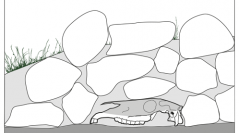

 Anthropozoologica
54 (15) - Pages 151-177
Anthropozoologica
54 (15) - Pages 151-177Deer stone and khirigsuur complexes are monuments that are characteristic of the Late Bronze Age (1200-700 BC) of the steppes of central and northern Mongolia. The khirigsuurs are made up of a large central mound around which are distributed peripheral structures: mounds and circles of stones. The peripheral mounds cover heads, vertebrae and phalanges of horses. At the centre of the circles of stones, the deposits consist of the burnt bones of caprines. This article discusses the ingredients that will allow us to better understand the gestures performed as part of the activities around the ritual monuments at Tsatsyn Ereg (Mongolia). The presence in certain mounds of a cranium and mandibles belonging to two different individuals reveals that the explanation for the horse deposits is more complicated than a simple action of in situ sacrifice. Analysis of age at death reveals that elderly animals are numerous. Males form a strong majority. The analysis of the almost 12 000 calcined remains recovered from the circles reveals that teeth and feet of caprines are disproportionately represented. The paper links the circles of stones that delimit the fireplaces with the action of purification. For the khirigsuur B10, the analysis of the alignment of the mounds and the stone circles and the orientation of the horses gives the impression of a herd of horses taking or pulling the deceased towards the rising sun. The communal aspect of the activities conducted around these large tombs is evident. We perceive all of the complexity of the deer stone and khirigsuur (DSK) phenomenon, which is simultaneously social and religious.
Khirigsuur, deer stones, stone circles, monument, horse, caprine, skull, calcined bones, pastoralism, zooarchaeology, Bronze Age.